Blog
Rome: The Ultimate Guide to Eating, Exploring & Living La Dolce Vita

This feature was produced with support from a commercial partner. Editorial control remains with the author.
It’s easy to see why Rome remains one of the world’s most beloved destinations. With a history stretching back over two thousand years, the city offers layer upon layer of wonders: ancient architecture, priceless works of art, and living traditions fiercely protected by generations of Romans. Every corner tells a story, every piazza holds a fragment of the past.
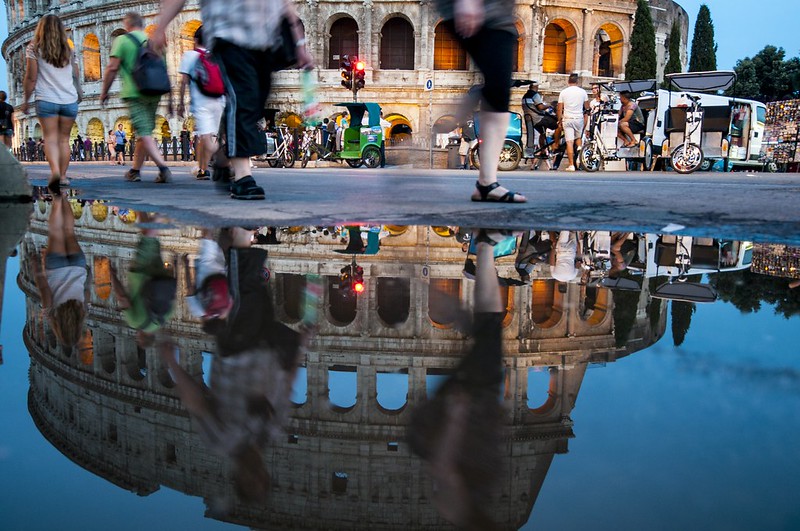
Yet Rome is not just a museum of antiquity—it is also a city of appetite. Food is woven into the rhythm of daily life. The beauty of Italian cooking lies in its simplicity and passion: a glass of wine and a perfectly cooked plate of pasta can quicken the heart in ways grand monuments never could. Add a nightly passeggiata, a slice of pizza eaten on the go, or a morning espresso sipped at the bar, and the ordinary becomes something magical.

Rome is, quite simply, irresistible. In this guide, you’ll find everything you need to live la dolce vita on your own trip: where to stay, what to eat, the must-see sights, and the little details that make the Eternal City unforgettable.

How to Get There
Rome is served by two airports, both operated by Aeroporti di Roma: Fiumicino (Aeroporto Leonardo da Vinci) and Ciampino. Fiumicino is the main international hub, located about twenty miles southwest of the city centre. The train station sits conveniently beside the arrivals hall, making transfers straightforward. The Leonardo Express runs directly to Termini station in around thirty-five minutes, while the FL1 suburban line connects with stations in the southern and eastern districts.
Ciampino, though smaller and mainly served by low-cost airlines, is actually closer to central Rome. Just nine and a half miles from Termini station, it is connected by buses such as SITBusShuttle and Terravision, with the journey taking around forty minutes.
Taxis are available from both airports and operate on a fixed fare to central Rome. From Fiumicino, the flat rate is €55 for up to four passengers, including luggage and applicable supplements. From Ciampino, the fixed fare is €40 for up to four passengers. These fares are set by the Municipality of Rome to provide transparency and prevent overcharging. While pricier than public transport, taxis can be a convenient option for early-morning or late-night arrivals.
Travel Tip
Confirm the fare with your driver before starting the journey and make sure to use an official white taxi marked with the "Comune di Roma" emblem.
Getting Around Rome
For most visitors, walking is by far the best way to explore Rome’s city centre. The streets are compact, and wandering on foot lets you stumble upon hidden piazzas, charming cafés, and centuries-old monuments that you might miss from a car window. Driving in Rome is not for the faint-hearted: traffic can be chaotic, scooters and Vespas weave between lanes, and the “rules” of the road often differ from what you might be used to.
If you need to venture further afield or prefer not to walk everywhere, Rome’s municipal bus network, run by ATAC, is extensive and reportedly reliable. Tickets are inexpensive and can be purchased at metro stations, newspaper stands, or tabacchi (look for the blue “T” sign). When buying a ticket, simply ask for “un biglietto per l’autobus, per favore”—the staff will know exactly what you mean. Tickets must be validated on board using the machines, and a single ticket is typically valid for 100 minutes across buses and trams.
Rome also has a metro system, though it is smaller than other European capitals. Lines A and B cover the main tourist areas, but many historic streets and piazzas are not directly served, so walking often remains the fastest and most scenic option.
Travel Tip
Consider downloading the official ATAC app or Google Maps before your trip to check real-time bus and metro schedules. This can save time and help avoid crowded stops during peak hours.
Accessibility & Mobility Tips
Rome’s historic streets can be challenging for those with mobility concerns, but it is not impossible to get around. Many major attractions are wheelchair accessible, including the Vatican Museums, Colosseum, and Castel Sant’Angelo. Public transport is improving, with ramps and accessible stations on the metro lines. Cobblestones and narrow alleys may require planning, but taxis and rideshare options are plentiful. Stroller-friendly routes are abundant in the piazzas and major parks, though some churches and side streets may require lifting children briefly.
Practical Tips for Visitors
Rome is largely safe but remains a busy city, so keep an eye on your belongings, especially near major attractions. Basic Italian phrases go a long way: a polite “per favore” and “grazie” will earn smiles everywhere. Tipping is optional but appreciated—5–10% in restaurants is common. Be prepared to walk extensively; comfortable shoes are a must. Entry fees for museums and historic sites vary, so booking tickets online can help you avoid long queues. For weather, spring and autumn offer mild temperatures and fewer crowds, while summer can be sweltering and very busy.

Rome for Families
Rome isn’t just for history buffs and romantics; it’s incredibly family-friendly. The Bioparco Zoo in Villa Borghese, the Explora children’s museum, and interactive exhibits at Palazzo Massimo engage kids of all ages. Many trattorias are welcoming to families and provide child-sized portions. Even the city’s piazzas become playgrounds in the evening, where children run freely while parents sip a caffé or aperitivo nearby. A family stroll through markets, picking up fresh fruit and pastries, is a simple yet memorable Roman experience. Exploring Rome together can be an adventure full of discovery, with something to delight every generation.
Where I Stay & Why
Rome offers accommodation to suit every taste and budget. From plush, world-famous five-star hotels to charming family-run guesthouses and practical self-catering apartments, there’s something for everyone. Great deals are available throughout the year, and Travel Scoop can help you find the perfect stay here.

I’ll guide you through my favourite neighbourhoods, starting with the one that captured my heart on my first visit: Trastevere. It’s a living postcard of Rome, with cobblestone streets, lively piazzas, and a sense of authenticity that never fails to enchant. Each corner reveals colourful market stalls, artisan shops, and locals going about their day—perfect for those who want to immerse themselves in the Roman rhythm rather than just tick off the sights.
Trastevere
I stayed in a tiny hotel — so small that I could stretch my arms and touch both walls, and I’m only 5’2”! What the room lacked in space, the neighbourhood more than made up for in charm. Trastevere is now my top recommendation for anyone seeking a truly authentic Roman experience.
The streets wind through cobblestone lanes, opening onto vibrant piazzas bustling with markets, cafés, and locals going about their day. Laundry swings from balconies, trattorias fill the air with the smell of simmering sauces, and the buzz of conversation drifts through the warm evening air. From Trastevere, it’s just a twenty-minute walk to the main city centre attractions, making it a wonderfully convenient base. Yet when you return in the evening, it feels like a calm, relaxed village tucked away from the city’s frantic energy.
Trastevere is an attraction in itself. Small family-run shops, artisanal markets, and beautiful churches await exploration, many of which you might have almost entirely to yourself. Grab a gelato and sit on a stone bench, watch the world go by, or lose yourself in the tiny side streets where every corner feels like a photograph waiting to happen. In the evenings, piazzas come alive with music, laughter, and the scent of wood-fired pizza wafting through the air, offering a quintessential Roman experience that lingers in memory long after you leave.

Centro Storico
The heart of Rome, the historic centre, is a tightly packed maze of cobblestone streets and alleys lined with Renaissance palaces, ancient ruins, and breathtaking baroque piazzas. This is the Rome most travellers picture: streets alive with boutiques, cafés, trattorias, and stylish bars, and squares animated by market traders, street artists, and performers. Beyond the famous sights, a closer look reveals hidden monuments, museums, and churches with masterpieces by Michelangelo, Caravaggio, Bernini, and other legends of art. Staying here puts you in the centre of the action, surrounded by history at every turn.
Strolling through Centro Storico, every corner seems to whisper a story. Piazza Navona’s fountains dazzle, tiny squares invite a moment’s pause, and narrow alleys reveal trattorias serving some of Rome’s most authentic dishes. At night, street lamps cast a golden glow on cobblestones, turning the neighbourhood into a cinematic playground of light, shadow, and history.
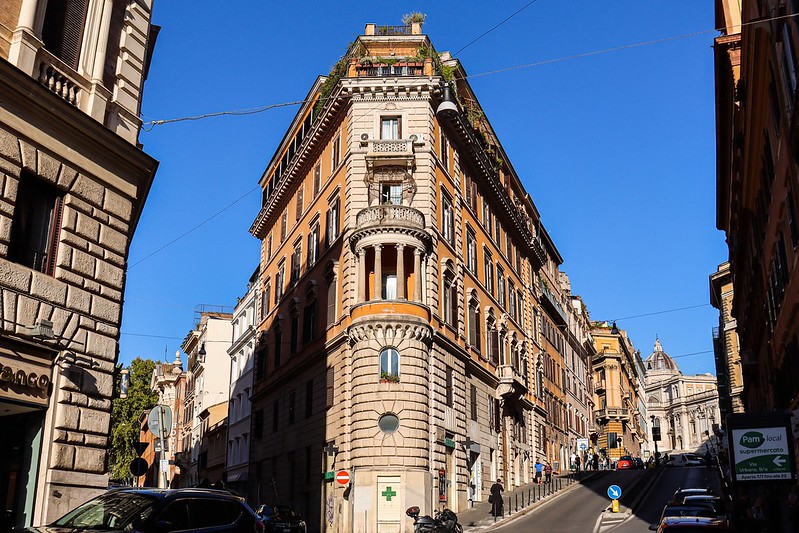
Prati
For those seeking something a little quieter, Prati is the ideal choice. This elegant neighbourhood is calm, particularly in the evenings, yet still within easy reach of the centro storico. It’s an excellent choice for families, offering space, a more relaxed pace, and a sophisticated atmosphere. Prati is full of fabulous shops, restaurants, and bars, so you won’t miss out on the city’s culinary or retail delights.
The area is also incredibly convenient for visitors to the Vatican, with the Vatican Museums and St. Peter’s Basilica practically at your doorstep. Whether you’re on a religious pilgrimage or just eager to explore one of the world’s most famous cultural sites, Prati provides a perfectly positioned, calm base. Wide boulevards, chic cafes, and quiet streets invite leisurely strolls, while evening aperitivos along tree-lined streets feel indulgent yet unhurried. It’s the best of both worlds: serenity and access to Rome’s bustling cultural treasures.
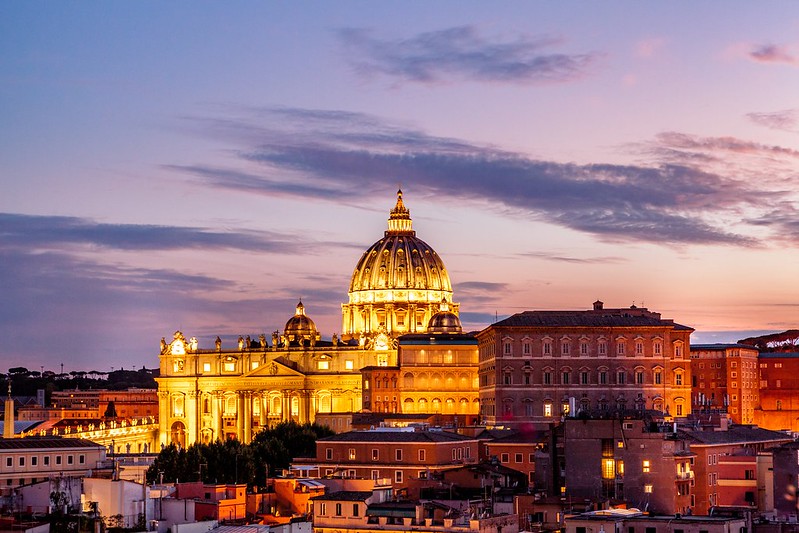
Food & Drink in Rome
Eating and drinking in Rome isn’t just about sustenance — it’s a full sensory immersion into the city’s soul. The smells of fresh espresso, simmering sauces, and wood-fired pizza mingle with the chatter of locals in sun-dappled piazzas, creating a rhythm you’ll find irresistible. Each meal feels like a moment suspended in time, where tradition, passion, and flavour converge. To navigate this culinary playground, a few insider tips will help you avoid tourist traps and dive straight into authentic Roman flavour.
Steer clear of restaurants in the busiest tourist areas, especially those with big photographs or printed menus outside. The true magic often lies a few streets away in small, family-run trattorias where the food speaks louder than the signage. Many of these restaurants may not even have a menu — instead, embrace the piatto del giorno, the dish of the day, and trust your tastebuds. Sit back, let the aromas lead you, and watch locals at neighbouring tables for clues on what to order.
Roman cuisine has a rich, fascinating history. Among its most iconic traditions is quinto quarto, or “the fifth quarter,” born in the Testaccio slaughterhouse at the end of the 19th century. Workers were partly paid in offal, and dishes like tripe, liver, and sweetbreads became a beloved local specialty. Adventurous eaters should not miss trying these — you might be pleasantly surprised by their rich, hearty flavours, often paired simply with fresh herbs and olive oil, highlighting the ingredients’ natural depth.
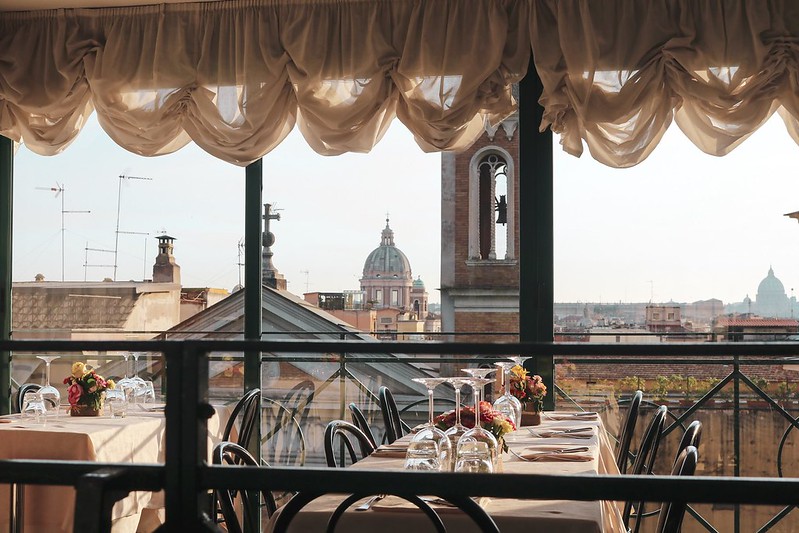
When it comes to drinks, locals take their customs seriously. Never pair pizza with wine — instead, order a beer, sparkling water (aqua frizzante), or a fizzy soft drink. A shot of espresso (un caffè) at the bar usually costs about one euro, and while sitting at a table costs slightly more, sometimes it’s worth it to rest your feet and soak up the atmosphere. Remember, cappuccino or caffe latte is strictly a morning drink; in the afternoon, try a caffè freddo, a sweetened iced espresso, or granita al caffè, a refreshingly icy coffee often topped with whipped cream. Avoid flavoured syrups — the local baristas take pride in tradition, though a caffè corretto (espresso with a touch of liqueur) is perfectly acceptable.
Coffee culture in Rome is an art form, and discovering the city’s historic cafés is a journey in itself. Antico Caffè Greco on Via dei Condotti, the oldest coffee shop in Rome, dazzles with its red velvet chairs, marble tabletops, and opulent interior. Stand at the bar to save a few euro, or linger over a pastry and soak in the grandeur. Da Nina in Trastevere is a small, family-run café with excellent coffee and a tempting array of freshly baked cakes, ideal for a quiet moment of reflection. Sant’Eustachio in Piazza di S. Eustachio has been caffeinating Romans since 1938, famous for its unique preparation — ask for your coffee zuccherato and watch the barista whip a sweet, frothy foam from the first few drops of espresso.
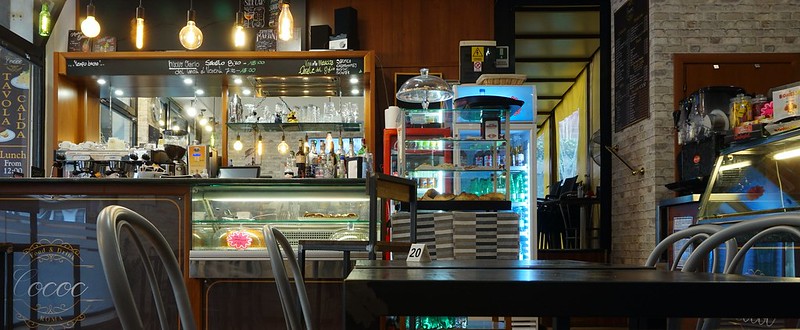
Rome’s evening scene is equally captivating. From charming enotecas (wine bars) tucked down cobbled alleyways to rooftop lounges with sweeping views, the city offers endless options for drinks. Sip a Negroni or a spritz as the sun sets over terracotta rooftops, or wander the streets on an evening passeggiata, letting the city guide you — every corner could hide your next favourite spot. Conversation, laughter, and clinking glasses spill into the night, blending effortlessly with the city’s ancient rhythm.
Of course, the city’s culinary treasures extend far beyond coffee and cocktails. Rome is bursting with restaurants and street food for every budget. Some favourites worth seeking out include Da Enzo in Trastevere, where wine-stacked walls, checkered tablecloths, and chalkboard specials evoke every dream of Italian dining. Bar la Licata near the Colosseum offers excellent coffee and lunch options — perfect for a midday pause after exploring the Forum. In Testaccio, Felice a Testaccio is a local institution, where the cacio e pepe is prepared tableside for added theatre, each twist of pasta a simple but unforgettable performance.
Other must-visits include Roscioli Salumeria con Cucina, steps from Campo de’ Fiori, serving Roman classics alongside fresh cheeses, cold cuts, and pickled delicacies. Trattoria Monti in the Monti neighbourhood delights with Le Marche-inspired dishes and a generous wine list, while Trattoria Pennestri offers rustic, seasonal cuisine in a cosy, inviting setting. For pizza lovers, Da Francesco in Piazza del Fico is small but unforgettable, with a wood-fired oven pumping out some of the city’s best pies.
Dining in Rome is more than just food; it’s an experience that engages all your senses. Wander through cobbled streets, linger over coffee, share a plate of pasta, and sip a glass of wine as the sun sets over the piazza. This is Rome at its most irresistible — la dolce vita on a plate, where every bite tells a story, and every sip tastes of centuries of culture.
Nightlife & Evening Entertainment
As the sun dips behind Rome’s terracotta rooftops, the Eternal City transforms. Streets that were quiet in the afternoon become alive with music, laughter, and the gentle hum of conversation spilling into cobbled piazzas. The warm evening air carries the scent of wood-fired pizza, espresso, and the occasional spritz from an open-air bar. Nighttime in Rome isn’t merely about going out; it’s a theatrical immersion, a symphony of lights, aromas, and the hum of history in the air.
In Trastevere, the piazzas become stages for street performers, live jazz bands, and spontaneous gatherings of locals and tourists alike. Cobblestone lanes twinkle under the glow of lamplight, while the chatter of aperitivo hour spills out from trattorias and wine bars. Outdoor tables are filled with friends clinking glasses, families sharing gelato, and couples lingering over candlelit dinners. Each corner feels intimate, each square a small festival of community life. Wander slowly, and you might stumble upon a tiny bar tucked behind ivy-covered walls, offering inventive cocktails or a perfectly chilled prosecco.

Monti, by contrast, is quieter, more bohemian. Here, tiny wine bars nestle in narrow alleys, and hidden cocktail lounges offer inventive libations crafted by mixologists who treat each drink like a work of art. The vibe is relaxed and sophisticated — a place to linger over a glass of red wine while watching the world pass by. The neighbourhood feels like a secret waiting to be discovered, with unexpected performances, tucked-away trattorias, and little piazzas that invite conversation under the stars.
For those who love rooftops, the historic centre offers breathtaking views of domes, spires, and softly illuminated piazzas. Sip a Negroni or an Aperol spritz as the city glows beneath you, and watch as the lights of Rome flicker to life, creating a panorama that feels cinematic and intimate at the same time. Each terrace bar has its own personality — some chic and minimalist, others opulent and classic — but all share one thing in common: the magic of the city at dusk.
Music lovers are spoiled for choice. From intimate jazz clubs where the notes float through vaulted ceilings, to classical ensembles in historic palaces, Rome’s evenings are rich with sound. Local bars often host acoustic nights, folk performances, or contemporary bands, blending tradition with modern energy. Whether your preference is relaxed and atmospheric or vibrant and energetic, there’s always a night out to suit your mood. Even a simple walk through a piazza can feel like a spontaneous concert, with street performers providing a soundtrack to the city.
For a truly Roman experience, combine your evening with a passeggiata — the traditional evening stroll. Saunter through piazzas, sip an aperitivo, listen to the distant strains of music, and take in the interplay of light and shadow on centuries-old facades. Stop at gelaterias for a sweet interlude or admire fountains illuminated by soft lighting, their waters sparkling like liquid gold. This is not just an evening; it’s a slow, sensory journey that connects past and present, locals and visitors, in the timeless rhythm of the city.
Finally, for those who prefer dancing or late-night energy, Rome offers clubs and venues ranging from chic cocktail lounges to vibrant nightclubs. Many host themed nights, DJ sets, or live music, giving you a taste of contemporary Roman nightlife alongside the ancient cityscape. No matter your preference, the city ensures that nightfall is never dull — it’s an invitation to experience Rome in a new, luminous light, where every street and square tells a story after dark.

What to See & Do in Rome
Rome is not just a city; it’s a living, breathing museum. Its streets echo with stories from over 2,500 years, and every piazza, alleyway, and fountain carries the weight of centuries. Here, history, art, and modern life collide in ways that feel both magical and intimate. Wander through ancient ruins, marvel at Renaissance masterpieces, sip an espresso in centuries-old cafés, and stumble upon hidden neighbourhood gems—all in one afternoon. This guide will immerse you in Rome, showing you not just what to see, but how to experience it like a local and truly live la dolce vita.

Colosseum
The Colosseum (Flavian Amphitheatre) is Rome’s most iconic ancient monument and one of the greatest architectural feats of antiquity. Built between 70–80 AD under the Flavian emperors, it could hold up to 80,000 spectators and hosted gladiatorial combats, wild animal hunts, mock naval battles, and public spectacles that defined Roman entertainment. Walking through its arches, corridors, and tiered seating, you can almost hear the roar of the crowd and imagine the anticipation of the games. Every stone tells a story, every passage holds centuries of history.
Guided tours offer access to the underground hypogeum, where gladiators and animals awaited their turn, and highlight the architectural innovations that allowed such a massive structure to endure. Evening visits are magical: bathed in golden light at dusk, the Colosseum stands as a testament to Rome’s grandeur. Nearby, the Arch of Constantine and the Roman Forum invite exploration, offering glimpses into the daily life, politics, and ceremonies of ancient Rome.

Vatican City
Even from afar, the Vatican is breathtaking. Its massive dome dominates the skyline, while St. Peter’s Square, with Bernini’s sweeping colonnades, creates one of the world’s most iconic cityscapes. But the real treasures lie within. Founded by Pope Julius II in the early 16th century, the Vatican Museums house an unparalleled collection of art spanning centuries. As you wander through 54 galleries, courtyards, and hallways, masterpieces by Raphael, Leonardo da Vinci, Caravaggio, and Michelangelo’s frescoes in the Sistine Chapel unfold in a visual feast.
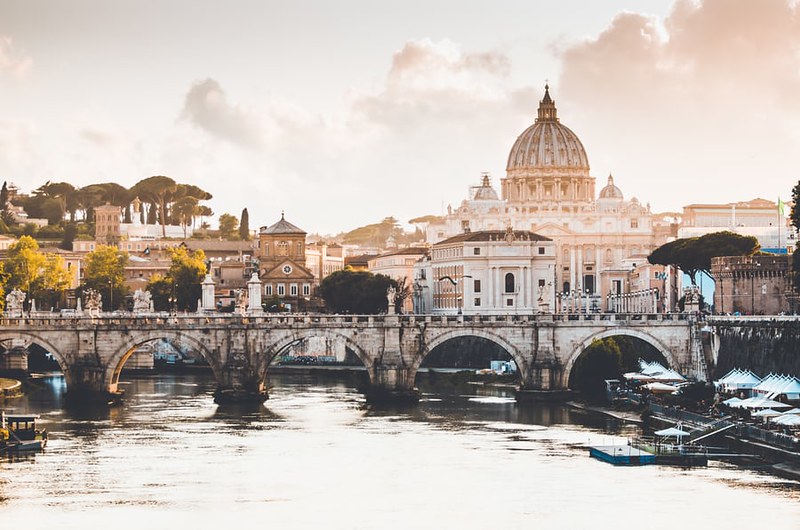
Plan ahead to explore the Vatican Necropolis beneath St. Peter’s Basilica. This underground network offers rare access to the tombs of early popes and saints. The Vatican Gardens are another often-overlooked gem: guided tours reveal fountains, ornate sculptures, hidden chapels, and a tranquil escape from the crowds. Every corner tells stories of devotion, artistry, and centuries of history.

Inside St. Peter’s Basilica, awe-inspiring masterpieces await: Bernini’s gilded baldachin above the papal altar, Michelangelo’s Pietà, and countless chapels rich with gold, marble, and frescoes. Climb the dome for a 360-degree panorama of Rome — from the bustling piazzas to the surrounding hills, a view that feels both expansive and intimate. Visit early in the morning or late afternoon to avoid peak crowds and enjoy a contemplative atmosphere.
Even without entering, St. Peter’s Square is mesmerizing. Watch the Swiss Guards in ceremonial formation, hear the echo of church bells, and observe pilgrims and tourists alike. It’s a place where history, faith, and modern life converge, creating a truly unforgettable experience.

Borghese Gallery and Museum
Galleria Borghese is both a museum and a villa, nestled within the lush Borghese Gardens. Commissioned by Cardinal Scipione Borghese in the 16th century, it houses an extraordinary collection of sculptures, paintings, and decorative arts. The villa itself is a masterpiece, with richly adorned rooms that feel as intimate as a private home yet hold treasures worthy of a palace.
Key highlights include Bernini’s Apollo and Daphne, a marvel of motion and emotion carved in marble; Canova’s Paolina Borghese, a neoclassical triumph; and Caravaggio’s Boy with a Basket of Fruit, whose realism and detail remain breathtaking. The surrounding gardens are equally enchanting, offering winding paths, shaded groves, and elegant fountains—a perfect place for a leisurely afternoon after your visit. Seasonal exhibitions and live performances occasionally enhance the experience, providing a contemporary twist on this historic setting.

Pantheon
The Pantheon is one of the best-preserved buildings of ancient Rome and a triumph of engineering and spiritual architecture. Originally built in 27 BC by Marcus Agrippa and rebuilt by Emperor Hadrian in 125 AD, it was dedicated to “all gods” (Pantheon translates to “all gods”). Its immense, unreinforced dome with the central oculus remains an engineering marvel and a symbol of Roman ingenuity.
Stepping inside, the Pantheon’s vast interior, bathed in light streaming from the oculus, conveys a sense of awe and serenity. The floors are patterned with ancient marble, and the walls house tombs of notable figures, including Raffaello Sanzio (Raphael) and Italian kings. Attend a Sunday Mass if you can, especially around Pentecost, when rose petals are dropped through the oculus—a magical and unforgettable spectacle that fuses history, architecture, and spiritual wonder.
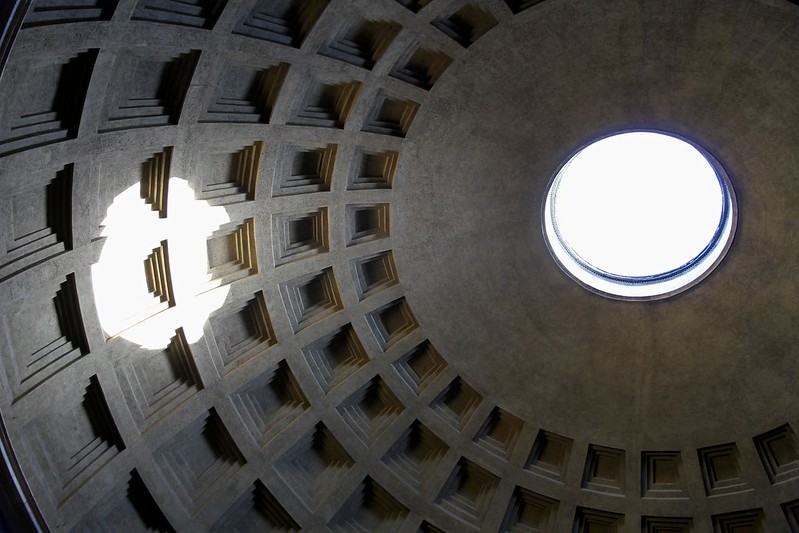
Trevi Fountain
The Trevi Fountain (Fontana di Trevi) is arguably Rome’s most famous fountain, a baroque masterpiece that mesmerizes visitors with its scale, craftsmanship, and drama. Standing 26 meters high and 20 meters wide, the fountain was designed by Nicola Salvi and completed by Giuseppe Pannini in 1762. It sits at the terminus of the Aqua Virgo aqueduct, built in 19 B.C., which once supplied water to ancient Rome’s baths and fountains.
The fountain’s central figure is Oceanus, commanding a chariot drawn by two sea horses, each guided by a Triton. Surrounding statues symbolize abundance and health, while the backdrop of Corinthian pilasters and niches integrates the fountain seamlessly into the architecture of the surrounding buildings. The sound of cascading water and the intricacy of the carvings combine to create an almost theatrical spectacle.
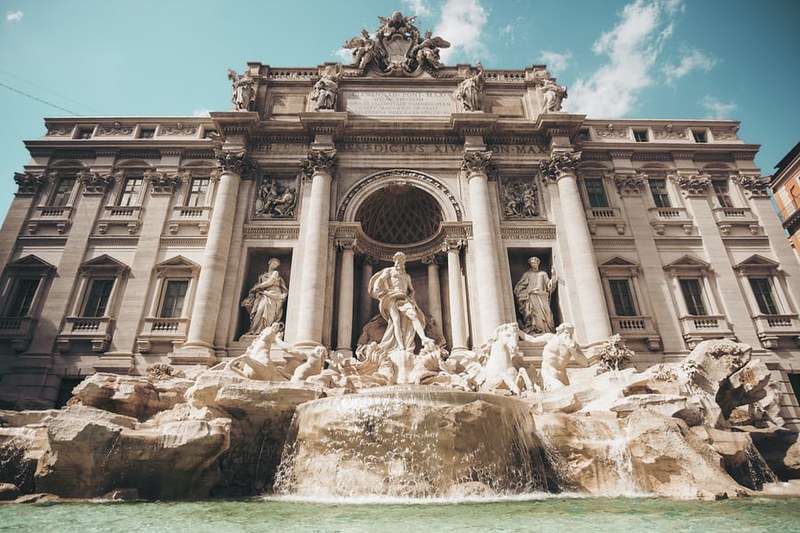
The Trevi Fountain is steeped in legend. Toss a coin with your right hand over your left shoulder to ensure a return to Rome. Two coins promise a romance with an attractive Italian, and three coins guarantee marriage. An estimated one million euros are collected each year, donated to charitable causes. Visit at different times for unique experiences: early morning for a quiet, reflective moment, or evening when the fountain is illuminated, casting a magical glow perfect for photos, romance, or simply soaking in the city’s charm. Nearby gelaterias and cafés complete the experience, letting you linger and truly taste Roman life.
La Passeggiata
The passeggiata is Rome’s cherished evening tradition, more than just a stroll—it’s a social ritual. As the sun sets, Romans of all ages take to the streets, dressing elegantly, sometimes extravagantly, to see and be seen. Piazza Navona, Campo de’ Fiori, and the streets of Trastevere come alive with laughter, chatter, and music, creating an atmosphere that feels timeless.
This is the perfect moment to sip an aperitivo, people-watch, and immerse yourself in the rhythm of local life. Children play, couples stroll hand in hand, and friends linger over drinks and gelato. Participating in the passeggiata is like stepping into a living postcard of Rome, where past and present mingle effortlessly in the warm evening air.
Mercato di Testaccio
Mercato di Testaccio is a haven for food lovers. Located in the working-class neighborhood of Testaccio, the market reflects the heart of Roman cuisine. Stalls overflow with fresh produce, cheeses, cured meats, seafood, and street food delicacies like supplì (fried rice balls) and porchetta sandwiches.
The market is vibrant, chaotic, and utterly authentic—a chance to rub shoulders with locals and taste culinary traditions rooted in centuries of Roman life. Seasonal products and rotating specials ensure each visit offers something new. Don’t just shop; linger, chat with vendors, and let the aromas guide your choices.
Chiesa di Sant’Ivo alla Sapienza
The Chiesa di Sant’Ivo alla Sapienza is a Baroque masterpiece designed by Francesco Borromini in the 17th century. Its spiraling “corkscrew” spire is visible from several points across Rome, a signature of Borromini’s architectural genius. Inside, the church is a geometric wonder, with intricate stucco work and a floor designed to draw the eye toward the altar. During summer, classical music concerts in the courtyard allow visitors to enjoy architecture paired with sublime music—an experience that elevates both senses and spirit.

Castel Sant’Angelo
Originally built as Emperor Hadrian’s mausoleum, Castel Sant’Angelo evolved into a fortress, papal residence, and prison over centuries. Its cylindrical silhouette dominates the banks of the Tiber, connected to the Vatican via the Passetto di Borgo, a secret elevated corridor used by popes to escape danger.
Visitors can explore the castle’s multiple levels, from ancient tombs and armories to lavish papal apartments adorned with frescoes. The rooftop terrace provides panoramic views of the Tiber, St. Peter’s Basilica, and the sprawling cityscape—especially magical at sunset. Temporary exhibitions also illuminate Rome’s layered history, making each visit uniquely memorable.
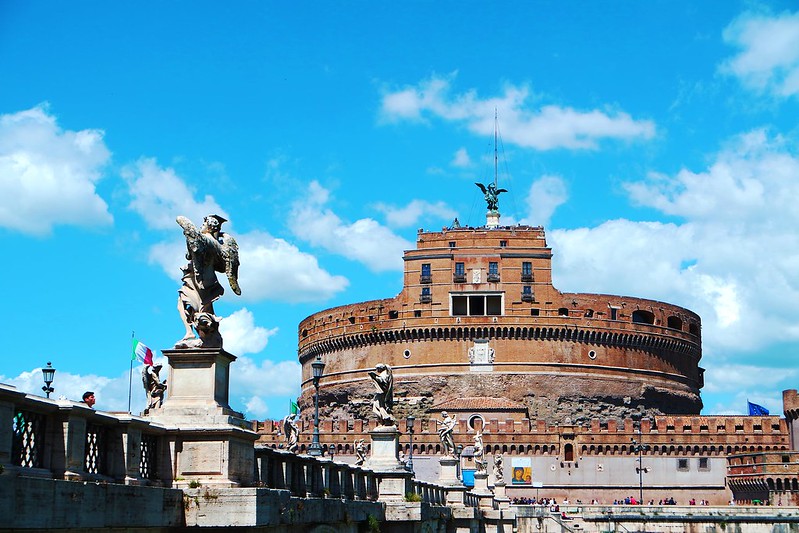
National Museums of Rome
The National Museums of Rome span four locations: Palazzo Massimo alle Terme, Palazzo Altemps, Baths of Diocletian, and Crypta Balbi. Together, they offer an unparalleled journey through Roman art, archaeology, and culture. Marvel at ancient mosaics, statues, coins, and frescoes, while interactive exhibits bring history to life. Whether exploring the intricate rooms of Palazzo Massimo or the monumental Baths of Diocletian, the museums provide a vital lens into Rome’s past and its influence on the modern world.
Complesso del Vittoriano
The Vittoriano, often called the “wedding cake” monument, dominates Piazza Venezia and is a striking tribute to Victor Emmanuel II, the first king of unified Italy. Its grand white marble facade and soaring colonnades are breathtaking. Visitors can climb to the terraces or take the glass elevator for panoramic views of the city, including the Roman Forum and Capitol Hill. Inside, Art Nouveau mosaics, the Altar of the Fatherland, and exhibits on Italian unification provide a blend of artistry, history, and civic pride.

Rome’s Streets & Markets
Rome is as much about wandering as it is about sightseeing. Every alley, cobblestone lane, and piazza offers a discovery. Campo de’ Fiori bustles with morning markets selling fresh flowers, produce, and local goods. Via del Governo Vecchio offers vintage treasures, artisanal boutiques, and quaint cafés, perfect for pausing and watching life unfold.
Exploring Rome on foot lets you stumble upon hidden gems: frescoed churches tucked behind palazzi, artisan gelaterias, and tiny squares where locals gather over espresso. Each street has a story; each market has a flavour; every corner invites you to pause, look, and soak in the living, breathing city. Markets overflow with colors, smells, and textures, drawing you into the sights, sounds, and tastes of Roman life.
Exploring the cobbled streets of Rome can be thirsty work; thankfully, the city is dotted with ‘nasoni’—fountains offering fresh water—so you can keep hydrated without buying bottled water, sustainability at its ancient best.

Pasta Museum
A must for food lovers, the Pasta Museum (Museo della Pasta) celebrates Italy’s most beloved culinary export. Beyond history, it presents pasta as art. Exhibits include ancient pasta-making tools, historic packaging, and intricate sculptures crafted entirely from pasta. Visitors can explore the evolution of shapes, techniques, and regional variations, with hands-on demonstrations and tastings bringing Roman and Italian culinary traditions vividly to life.
Capitoline Hill
Capitoline Hill (Campidoglio) is the smallest of Rome’s famous seven hills, yet its historical and political significance is immense. Once the heart of ancient Rome, it hosted temples, political institutions, and religious rituals. The hill overlooks the Roman Forum, symbolizing the power and prestige of Rome.

During the Renaissance, Pope Paul III commissioned Michelangelo to redesign the hill’s piazza, now Piazza del Campidoglio. Michelangelo’s genius is evident in the harmonious proportions, the trapezoidal layout, and the dramatic placement of the Equestrian Statue of Marcus Aurelius—a Roman bronze original, with a replica now standing in its place for protection. Surrounding palazzi—Palazzo Senatorio, Palazzo dei Conservatori, and Palazzo Nuovo—house the Capitoline Museums, showcasing classical sculpture, Renaissance art, and archaeological treasures.
The terraces offer panoramic views of the Roman Forum, the Colosseum, and beyond, creating a breathtaking backdrop for reflection. Wandering through the museums and piazza, you trace the evolution of Roman power, from the ancient Republic to the Renaissance papacy.
Piazza Navona
Piazza Navona is one of Rome’s most celebrated squares, where history, art, and daily life converge. Its origins date to the 1st century AD as the Stadium of Domitian (Stadio di Domiziano), used for athletic contests. The elongated oval shape still mirrors the stadium’s footprint, evoking the cheers of ancient spectators.
During the Renaissance, Piazza Navona became the elegant square we see today, with palazzi, fountains, and open spaces for markets and gatherings. The southern end features Fontana del Moro, depicting a Moor wrestling a dolphin, while the northern tip holds Fontana del Nettuno, portraying Neptune battling the sea. Palazzo Pamphilj frames the square, housing the Brazilian Embassy, while cafés spill out onto the cobbles, offering front-row seats to the vibrant Roman theatre of life.
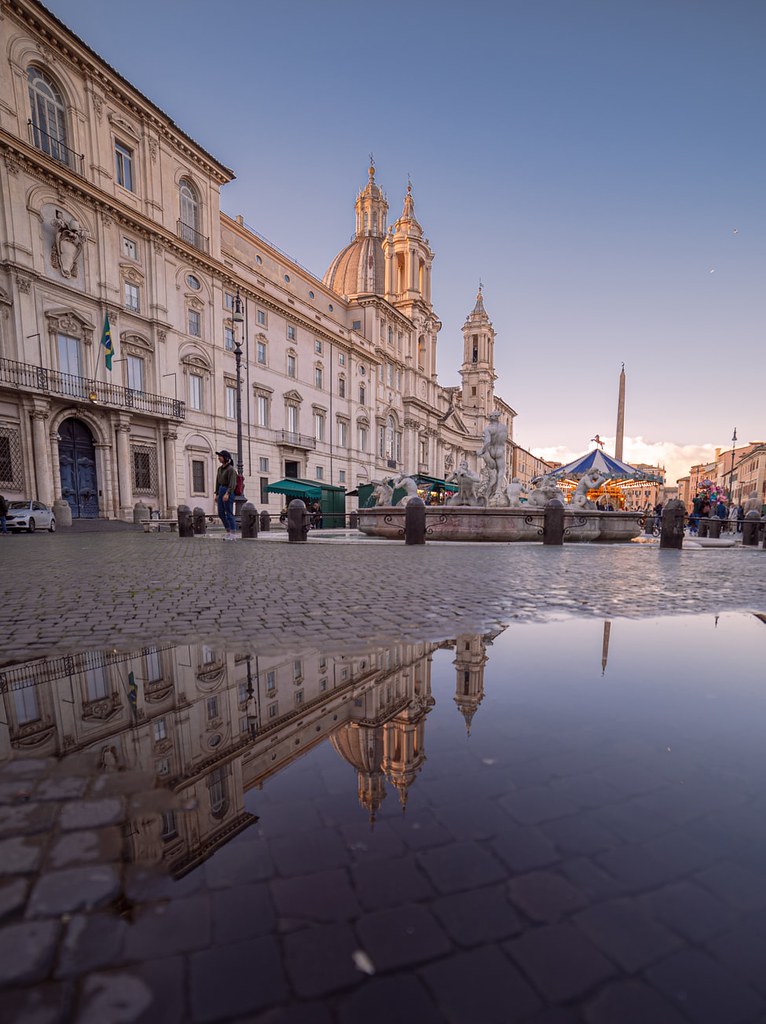
Early mornings provide calm, with soft light illuminating the fountains. Later, the square bursts with life, families enjoying gelato, musicians filling the air, and seasonal events adding layers to its rich cultural tapestry. Piazza Navona is more than a square—it is a living narrative, blending antiquity, Renaissance grandeur, and the pulse of everyday Roman life.
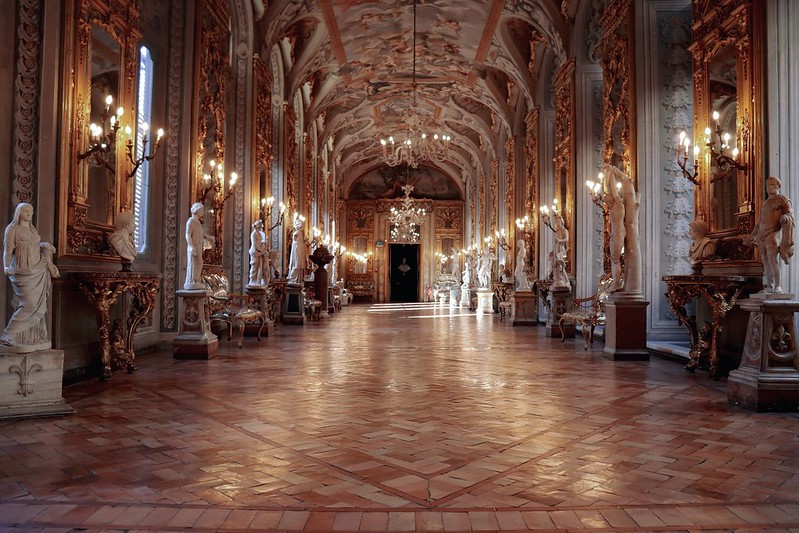
The Spanish Steps
The Spanish Steps (Scalinata di Trinità dei Monti) are among Rome’s most iconic meeting points, a staircase of 135 steps linking Piazza di Spagna at the base with the Trinità dei Monti church above. Built between 1723 and 1725 by Francesco de Sanctis and Alessandro Specchi, funded by a French diplomat, they connect the Spanish Embassy to the church.
The steps are a social and cultural stage, crowded with locals and visitors sitting, chatting, and soaking up Roman atmosphere. Springtime brings vibrant azaleas, adding a photogenic spectacle. At the foot, Fontana della Barcaccia, by Pietro and Gian Lorenzo Bernini, shaped like a sinking boat, remains a favourite for tossing coins or admiring its sculptural ingenuity.
Climbing to Trinità dei Monti, enjoy sweeping views of rooftops, domes, and piazzas. The church’s twin bell towers offer a serene counterpoint to the bustling steps below. Sunset is particularly magical, bathing the city in soft amber light, perfect for a pause before exploring nearby streets.

Hidden Gems & Off-the-Beaten-Path Spots
Beyond the famous piazzas and monuments, Rome conceals countless treasures. The Aventine Hill Keyhole provides a perfectly framed view of St. Peter’s Basilica, while Giardino degli Aranci offers panoramic sunset vistas over the city. Palazzo Doria Pamphilj hides a private art collection including Caravaggio and Velázquez, and small churches like Santa Maria della Concezione reveal crypts adorned with bones in unexpectedly beautiful arrangements. These discoveries reward the curious traveller willing to stray from guidebook routes and wander Rome’s quieter corners.

Shopping in Rome
From luxury designer avenues to quirky artisan shops, Rome is a shopper’s paradise. Via Condotti, Via del Babuino, and Piazza di Spagna cater to high-fashion lovers with flagship boutiques from Prada, Gucci, Valentino, and more. For a more local flavour, explore the lanes of Trastevere or Campo de’ Fiori for handcrafted leather goods, vintage treasures, and Roman ceramics. Food lovers will delight in specialty shops selling olive oils, wines, cured meats, and fresh pasta—perfect souvenirs or gifts. Don’t overlook street markets, where colourful stalls brim with antiques, books, and jewellery; haggling is part of the fun.
Day Trips from Rome
Rome is perfectly positioned for day trips to remarkable destinations. Tivoli, just 30 minutes away, is home to Villa d’Este with its Renaissance gardens and fountains, and Hadrian’s Villa, a sprawling archaeological wonder. Ostia Antica, a short train ride, offers a preserved glimpse into ancient Roman port life without the city-centre crowds. Orvieto, perched atop volcanic cliffs in Umbria, is famed for its cathedral and underground tunnels. For those ready for a longer journey, Florence or Pompeii can be reached by train in a few hours, each offering a different slice of Italy’s rich heritage. These excursions provide contrast to the bustling streets of Rome, letting travellers experience Italy’s diversity in a day.

Seasonal Tips & Festivals
Rome’s character shifts with the seasons. Spring bursts with flowers in the gardens of Villa Borghese, and Easter celebrations at the Vatican draw crowds for processions and special masses. Summer evenings are filled with outdoor concerts and cinema under the stars as part of estate romana. Autumn brings cooler temperatures, harvest festivals, and chestnut fairs. Winter showcases festive lights, Christmas markets in Piazza Navona, and traditional seasonal treats like panettone and roasted chestnuts. Planning your visit around these events lets travellers experience Rome as Romans do, not just as tourists.

FAQs About Visiting Rome
What are the must-see piazzas in Rome?
Piazza Navona, Piazza di Spagna, and Campo de’ Fiori are essential. Each has its own history, fountains, and vibrant street life, perfect for wandering, people-watching, or enjoying a gelato.
When is the best time of day to visit the Trevi Fountain?
Early morning is ideal for quiet reflection and photography, while evening brings a magical atmosphere with lights illuminating the cascading water.
How much time should I spend at the Borghese Gallery?
Plan for 2–3 hours to fully enjoy the sculptures, paintings, and the villa itself. Booking tickets in advance is essential, as visits are timed and limited.
What local foods should I try at Mercato di Testaccio?
Is it safe to walk around Rome at night?
Yes, most central areas like Trastevere, Piazza Navona, and Campo de’ Fiori are lively and safe after dark, though always stay aware of your surroundings.
How do I get to the Aventine Hill Keyhole?
Head to Piazza dei Cavalieri di Malta in the Aventine district. The keyhole frames a stunning view of St. Peter’s Basilica and is best enjoyed at sunset.
Can you do a day trip to Tivoli or Ostia Antica from Rome?
Absolutely! Tivoli takes around 30 minutes by car or bus and offers Villa d’Este and Hadrian’s Villa, while Ostia Antica is a short train ride, revealing a preserved ancient port town.
Are there any free events or festivals worth attending?
Yes, Rome hosts estate romana outdoor concerts in summer, harvest festivals in autumn, and festive Christmas markets in winter. These events give a glimpse of local life beyond the main sights.
Note: Originally published December 2020; updated September 2025. Stock photography used from various sources.
✨ Stay Connected with Culinary Travels ✨
Loved this post? 🍴 Don’t let the conversation end here! Join me for behind-the-scenes kitchen moments, foodie adventures, and plenty of inspiration:
👉 Facebook | Instagram | Pinterest
💌 Got thoughts, questions, or your own foodie stories to share? I’d love to hear from you — just drop me a note through my contact form.
📬 Hungry for more?
Subscribe to my newsletter for exclusive recipes, travel tips, and behind-the-scenes foodie fun: Sign up here
🌍 Sharing is caring! If this post made you hungry for more, please pass it along. Every share helps this little corner of the internet grow, and I’m so grateful for your support. ❤️


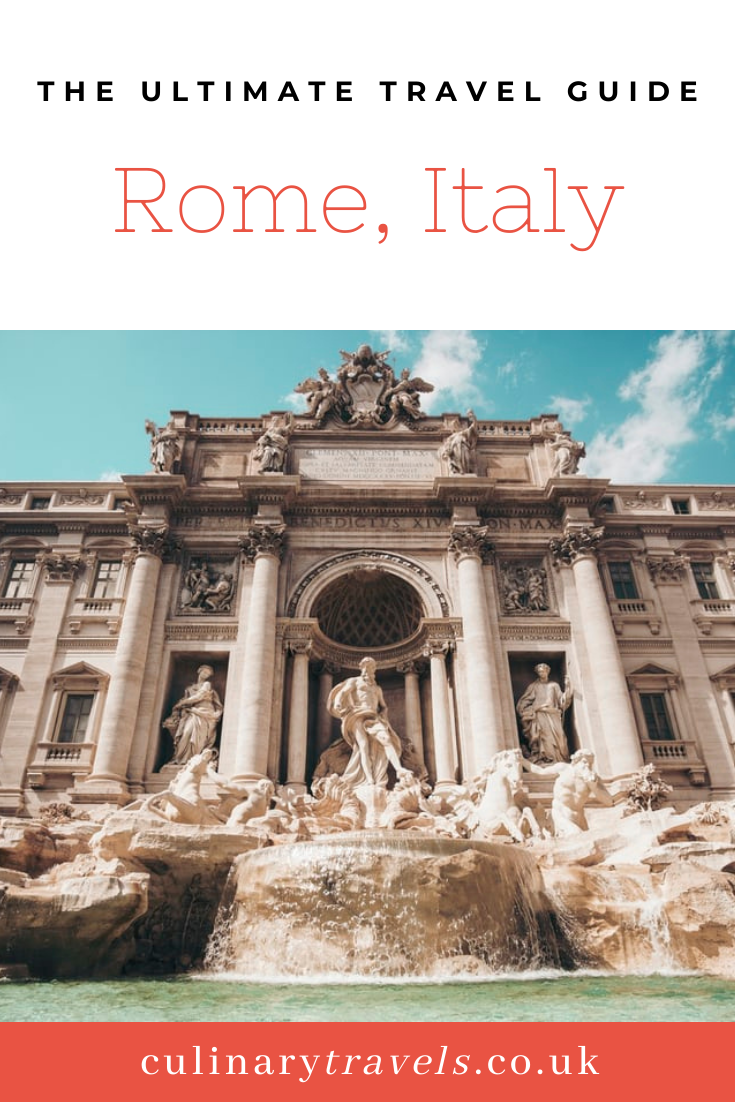


What Our Followers Say
"Oh yum!!! I could eat one or two right now!"
Sami Tamimi
"Georgina was great to work with, quick to respond, and is an excellent content writer - would highly recommend collaborating with her!"
Nick S, Get Blogged
Our list of things to do in Cork has just expanded hugely thanks to Culinary Travels.
Triskel Art Centre Cork